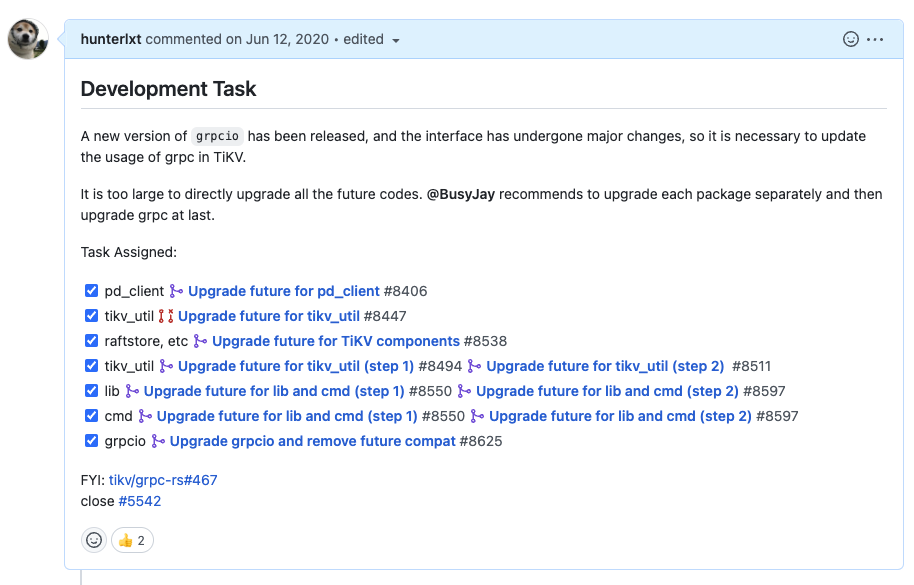让 TiKV 愉快地使用 async/await 异步编程模型
几个月前,接了一个大坑,因为 std::future 趋于稳定,官方的 async/await 也进入了 stable 版本,作为坚决拥护 rust 社区的项目,为 TiKV 升级 future 并引入 async/await 也被提上了日程。这里主要总结下作为 Rust 菜🐔在异步编程范式下的一些东西。

升级 Future 的背景
TiKV 里大量使用了异步编程模式,但是在过去这些代码使用的主要由 futures 0.1 这个库,它在官方没有提供 std::future 之前几乎是 Rust 里想要实现异步的事实标准库。但是在去年官方正式支持了 async await 关键字,也提供了官方的 Future trait 定义,但并没提供太多的周边功能,例如 timer、sink、channel、stream 等功能。因此想顺利地玩转 Rust 异步,依然需要这个半官方库,配合 rust 标准库的升级,futures 也发布到了 0.3,但是因为使用方式发生了巨大的改变,升级到 futures 0.3,尤其在 TiKV 这样的大型项目还是比较困难的。
Rust Future 现状
- Future 在 Rust 中是惰性的,只有 poll 才会得到进展
- Async 是零开销的
- Rust 不内置 runtime
- 单/多线程的 runtime 都可以,但各有优缺
异步 rust 比同步 rust 更难使用,并且也带来了更多的维护负担,但良好的设计也能获得一流的性能。虽然 rust 现在提供异步支持,但是很多功能由库实现。
使用带来的挑战:
-
编译错误:异步 rust 依赖很多复杂的语言特性,比如 lifetime 和 pin,因此可能会遇到更多的编译错误提示。
-
运行时错误:stack trace 更加复杂。
-
新错误模式:当你在 async context 下调用了阻塞函数或没正确实现 Future trait。
异步具有传染性,这句话我理解为当底层函数提供了异步的接口,这要求整个上层的 runtime 都必须以异步执行,说直白点,你不能直接在创建的普通线程直接 block_on 一个 future,这会让 future 回退到同步模式,你需要使用一个异步的 runtime(可以是由多线程组成 or 仅仅单线程也可)来执行这个 future。一个 Runtime 一般由两部分组成 1.executor 2.Reactor。Rust 的 Future 被设计成通知并运行的形式。因此 reactor 的工作就是负责通知,executor 负责运行,两者的交互通过 Waker 类型交集。
// futures 0.3 or std::future
pub trait Future {
type Output;
fn poll(self: Pin<&mut Self>, cx: &mut Context<'_>) -> Poll<Self::Output>;
}
// futures 0.1
pub trait Future {
type Item;
type Error;
fn poll(&mut self) -> Poll<Self::Item, Self::Error>;
}
大型项目的挑战
升级 future 我这里选择了反金字塔的过程,这样可以将 PR 独立提交,对每个 crate 分别进行升级,grpc-rs 依然使用 0.1 的版本,当其他的升级都完成了,再升级 grpc-rs。futures 提供了 compat 以让你可以将 Future 在 0.1 和 0.3 之间转换,这个功能是分离升级的关键。而且各个 crate 通常会使用一些对方的接口(不能循环),因此想象这是一个树状依赖结构关系,你最好从叶子节点开始动手。
总结即为,找到被依赖最少的节点,对你升级的模块进行隔离,对与其交互的部分使用 compat,以此类推知道升级完所有的老旧代码。
futures 0.3 的变化
首先是最基本的 Future trait 的定义发生了变化,过去的 Error 如今需要你自己为 Output 实现一个 Result 的结构体,好消息是大量本就不需要 Error 的地方可以省略掉了。
Pin
除了基本的 trait,下一个就要深刻理解 pin。因为只有被 pin 住的对象才能调用 poll or poll_next, balabala…. 但这是个什么呢?
future 是一个可以被 move 的对象,但是考虑如下代码:
async {
let mut x = [0; 128];
let read_into_buf_fut = read_into_buf(&mut x);
read_into_buf_fut.await;
println!("{:?}", x);
}
当它被移动后实际的内存地址可能发生变化,下次继续执行用的就是错误的指针地址,所以我们需要 pin,它可以把 future 固定在内存中固定的位置,这样在 async 内部就可以安全的创建引用了。Pin 类型其实包裹了一个指针类型,保证了该指针所指向的值不会移动。Pin<&mut T>, Pin<&T>, Pin<Box<T>> 都表示了 T 不会被移动。但还有一些类型移动的时候是保证没问题的,比如 u8,就实现了 Unpin。我们可以方便地使用类似 Box::pin() 来创建出实现了 Unpin 的类型。
// A function which takes a `Future` that implements `Unpin`.
fn execute_unpin_future(x: impl Future<Output = ()> + Unpin) { /* ... */ }
let fut = async { /* ... */ };
execute_unpin_future(fut); // Error: `fut` does not implement `Unpin` trait
// Pinning with `Box`:
let fut = async { /* ... */ };
let fut = Box::pin(fut);
execute_unpin_future(fut); // OK
async/await
有了这两个关键词,我们可以在升级后省很多代码量。比如在 components/pd_client/src/client.rs 这个例子:
// 0.1
Box::new(handler.map_err(Error::Grpc).and_then(move |mut resp| {
// 0.3
Box::pin(async move {
let mut resp = handler.await?;
过去的 0.1 会倾向使用大量的链式调用 a_future.map_err().and_then().map_err().and_then(),这样写人都要傻了,如今你完全可以像写同步代码那样写异步的编程,只要他们在 async block 包裹就可以,其中 await 代表这部分必须等到这个 future 被返回了结果才能继续执行后面的代码。
后面复习一下这两个关键字:
async 有两种写法,一种是 async fn,一种是 async 代码块。不管怎么样,里面的代码都是惰性的,必须用 executor 来驱动它们运行。内部可以有 .await 意思就是非得 block 在这里直到推进下去。
async Lifetimes
和传统得函数不太相同,async fn 接收的引用或者其它非静态生命周期的参数,返回的 future 也被生命周期所限定。
async fn foo(x: &u8) -> u8 { *x }
// 上下两个等价
fn foo_expanded<'a>(x: &'a u8) -> impl Future<Output = u8> + 'a {
async move { *x }
}
这说明 async 建立的 future 是可能携带有生命周期限制的。意思就是运行 await 的时候都要确认其生命周期还是有效的。
fn bad() -> impl Future<Output = u8> {
let x = 5;
borrow_x(&x) // ERROR: `x` does not live long enough
}
fn good() -> impl Future<Output = u8> {
async {
let x = 5;
borrow_x(&x).await
}
}
async move
不过也可以学习闭包,直接接管所使用变量的生命周期。
/// `async` block:
///
/// Multiple different `async` blocks can access the same local variable
/// so long as they're executed within the variable's scope
async fn blocks() {
let my_string = "foo".to_string();
let future_one = async {
// ...
println!("{}", my_string);
};
let future_two = async {
// ...
println!("{}", my_string);
};
// Run both futures to completion, printing "foo" twice:
let ((), ()) = futures::join!(future_one, future_two);
}
/// `async move` block:
///
/// Only one `async move` block can access the same captured variable, since
/// captures are moved into the `Future` generated by the `async move` block.
/// However, this allows the `Future` to outlive the original scope of the
/// variable:
fn move_block() -> impl Future<Output = ()> {
let my_string = "foo".to_string();
async move {
// ...
println!("{}", my_string);
}
}
多线程中的 .await
使用多线程 Future executor 时,Future 可能会在线程之间移动,因此异步主体中使用的任何变量都必须能够在线程之间传播,因为任何 .await 都可能导致切换到新线程。
这就说明使用到外部的变量必须实现 Send trait。而且一定要注意,在 .await 之间只用非 future 感知的锁很危险,可能会造成 executor 线程池锁住:考虑一个单线程的 executor,一个任务可能拿到了一个锁,然后通过 .await 归还给了调度器(.await 很容易切换任务),另一个任务尝试拿到锁就 block 了当前线程,而当前线程被 block 整个程序僵在了这里,就会死锁。为了避免这个使用 futures::lock 。
Waker
Task 表示被提交给 executor 的 Future。waker 提供了一个 wake 方法以告诉 executor 关联的任务应该被唤醒,当 wake 被调用后,executor 就知道和这个 waker 相关联的任务可以被推进了。Waker 被实现了 clone 所以它可以被复制和存储。
这个例子实现用 waker 实现一个简单计时器。在检测到任务没完成就把 cx.waker().clone() 给这个 future 里的共享字段存起来,每次都这样做一遍是因为一个 future 可能在 executor 中在不同的 task 中移动,这样及时地更新 waker 以确保唤醒成功。完成这个实验后 future 还是不能用,因为我们还没有 executor。
最后
当然不是所有的代码都能升级,比如有个测试用到了 spawn.poll_future_notify,这个在 0.3 没有对应的方法,所以只能把整个测试重写一遍实现类似的功能:
#[test]
fn test_switch_between_sender_and_receiver() {
let (tx, mut rx) = unbounded::<i32>(4);
let future = async move { rx.next().await };
let task = Task {
future: Arc::new(Mutex::new(Some(future.boxed()))),
};
// Receiver has not received any messages, so the future is not be finished
// in this tick.
task.tick();
assert!(task.future.lock().unwrap().is_some());
// After sender is dropped, the task will be waked and then it tick self
// again to advance the progress.
drop(tx);
assert!(task.future.lock().unwrap().is_none());
}
#[derive(Clone)]
struct Task {
future: Arc<Mutex<Option<BoxFuture<'static, Option<i32>>>>>,
}
impl Task {
fn tick(&self) {
let task = Arc::new(self.clone());
let mut future_slot = self.future.lock().unwrap();
if let Some(mut future) = future_slot.take() {
let waker = task::waker_ref(&task);
let cx = &mut Context::from_waker(&*waker);
match future.as_mut().poll(cx) {
Poll::Pending => {
*future_slot = Some(future);
}
Poll::Ready(None) => {}
_ => unimplemented!(),
}
}
}
}
impl ArcWake for Task {
fn wake_by_ref(arc_self: &Arc<Self>) {
arc_self.tick();
}
}
